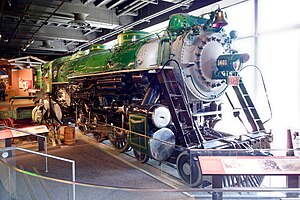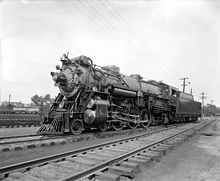Southern Railway 1401
| Southern Railway 1401 | |||||||||||||||||||||||||||||||||||||||||||
|---|---|---|---|---|---|---|---|---|---|---|---|---|---|---|---|---|---|---|---|---|---|---|---|---|---|---|---|---|---|---|---|---|---|---|---|---|---|---|---|---|---|---|---|
 Southern Railway No. 1401 on static display at the National Museum of American History in 2013 | |||||||||||||||||||||||||||||||||||||||||||
| |||||||||||||||||||||||||||||||||||||||||||
| |||||||||||||||||||||||||||||||||||||||||||
| |||||||||||||||||||||||||||||||||||||||||||
| |||||||||||||||||||||||||||||||||||||||||||
| References:[1][2][3][4] | |||||||||||||||||||||||||||||||||||||||||||
Southern Railway 1401 is a 4-6-2 steam locomotive built in July 1926 by the American Locomotive Company (ALCO) of Richmond, Virginia, for the Southern Railway (SOU) as a member of the Ps-4 class, which was based on the United States Railroad Administration (USRA) Heavy Pacific design with some minor differences. It was assigned to haul SOU's premier passenger trains between Washington, D.C., and Atlanta, Georgia.
Painted in a Virginian green and gold paint scheme, No. 1401 and the other Ps-4s were signified as the First Ladies of the Pacifics around the SOU system. Originally built with Baker valve gear and alligator crossheads, the Ps-4s were eventually re-equipped with Walschaerts valve gear in the 1930s and multiple-bearing crossheads in the 1940s.
During 1945, No. 1401 hauled the funeral train of U.S. President Franklin D. Roosevelt. Retired from revenue service by the SOU in 1952, No. 1401 was donated to the National Museum of American History in Washington, D.C., around 1961, where it remains on permanent display as the sole survivor of the Southern Railway Ps-4 class.
History
[edit]Design and appearances
[edit]
During the 1920s, the Southern Railway's (SOU) roster consisted of smaller P-1, Ps-2, Ps-3, and P-5 class 4-6-2 Light Pacifics that could not handle the longer and heavier mainline passenger trains between Washington, D.C., and Atlanta, Georgia.[3][5] Therefore, the SOU ordered the more powerful 4-6-2 Heavy Pacific Ps-4 class with a total of 27 locomotives (Nos. 1366–1392), built between 1923 and 1924 by the American Locomotive Company (ALCO) of Schenectady, New York, and were originally painted black with golden yellow linings and lettering.[6][a] The Ps-4s were based on the United States Railroad Administration (USRA) Heavy Pacific design, differing in that they lacked the smaller 73 in (1.854 m) driving wheels, and included a slightly shorter boiler, an additional firebox combustion chamber, and a Worthington 3-B type feedwater heater.[3][9] These arrangements made the Ps-4s produce 47,535 lbf (211.45 kN) of tractive effort, which allowed them to pull 14 passenger cars at 80 mph (129 km/h) on the SOU's hilly terrain.[3][9]
During 1925, SOU president Fairfax Harrison traveled to the United Kingdom where he admired the country's London and North Eastern Railway's (LNER) apple-green Gresley A1-class locomotives, which inspired him to repaint the Ps-4s and the SOU's other passenger locomotives in a new Virginian green and gold paint scheme.[10][11] This included the second batches of twelve locomotives (Nos. 1393–1404) built in the summer of 1926 by ALCO's Richmond Works in Richmond, Virginia, at a cost of US$56,419 each (equivalent to $777,717 in 2023).[12] Additionally, they were equipped with an Elesco feedwater heater as opposed to the Worthington type.[3][b] Because of the Ps-4s' glamorous Virginian green and gold paint scheme, they were signified as the First Ladies of the Pacifics around the SOU system.[14][15][c]
In 1928, the last batch of five Ps-4s (Nos. 1405–1409) were built by the Baldwin Locomotive Works (BLW) in Philadelphia, Pennsylvania, at a cost of $57,000 each (equivalent to $804,779 in 2023).[12] While the 1923–1926 batches were equipped with Baker valve gear, the 1928 locomotives were built with Walschaerts valve gears.[3][7] No. 1409 was experimentally equipped with a Coffin feedwater heater, which was later removed in the 1940s in favor of the Worthington SA type.[1][17]
Nos. 1366–1404 were eventually re-equipped with Walschaerts valve gears in the mid-late 1930s.[18] In the 1940s, all of the Ps-4s were re-equipped with multiple-bearing crossheads as opposed to their original alligator crossheads.[1][18] Additionally, Nos. 1366–1409 were all rebuilt with the higher and straighter front running board to allow more room around their cylinders and running gear for the crew maintaining the mechanical lubricating system.[1]
Revenue service and retirement
[edit]
No. 1401 was the forty-sixth member of the Ps-4 class and was one of the second batches built in 1926.[19] It was assigned to pull SOU's premier passenger trains such as the Crescent Limited and the Piedmont Limited, mostly on SOU's Charlotte Division between Salisbury, North Carolina, and Atlanta.[19][13][d] In 1941, SOU began to modernize their premier passenger trains with their new EMD E6 diesel locomotives to pull, while No. 1401 and the other Ps-4s were relegated to haul local passenger trains and mail trains on the Washington, D.C. to Atlanta main line.[20][21] Additionally, the Ps-4s were in motive power pool service, where they were called in to pull SOU's premier passenger trains again whenever one of the diesel locomotives was unavailable.[22][23]
On the night of April 25, 1942, No. 1401 was double heading with sister locomotive No. 1403, pulling the Atlanta Special passenger train from Atlanta to Washington, D.C., but crashed into a stalled truck at a railroad crossing in Norcross, Georgia, derailing both locomotives with the first four cars and injuring 12 or 13 people.[24] They were both repaired and put back into service.[24] In April 1945, No. 1401 became one of the eight Ps-4 locomotives to haul the funeral train of U.S. President Franklin Roosevelt from Atlanta to Washington, D.C.[25][26] It was leading the funeral train along with sister locomotive No. 1385 from Greenville, South Carolina to Spencer, North Carolina.[25] No. 1401's last heavy repairs took place at SOU's Spencer Shops in Spencer, North Carolina, on May 21, 1951.[27]
In November 1952, the No. 1401 locomotive was retired after it finished its last revenue run on the SOU's Danville Division between Salisbury and Monroe, Virginia.[27] It had traveled nearly 2,000,000 miles (3,200,000 km) during its revenue service.[26] During that time, railfan Walter H. Thrall and Washington, D.C., lawyer W. Graham Claytor Jr. convinced SOU president Harry A. DeButts to salvage one of the Ps-4 locomotives and donate it to the Smithsonian Institution in Washington, D.C.[27][28] In February 1953, the No. 1401 locomotive was chosen for preservation and was towed to Alexandria, Virginia, to be stored at the Henry Street Yard to await the Smithsonian's decision.[27][e] In 1955, the Smithsonian announced that they purchased the No. 1401 locomotive and would it put on display inside their new Museum of History and Technology exhibition building.[27]
In November 1961, the No. 1401 locomotive was cosmetically restored and transported via flatbed truck to the Smithsonian's under construction Museum of History and Technology building, which opened in early 1964 and later renamed to National Museum of American History in 1980 to reflect its scope of American history.[29][30] The No. 1401 locomotive currently remains on permanent static display at the Smithsonian as the sole survivor of the Southern Railway Ps-4 class.[31][32]
See also
[edit]- Atlanta and West Point 290
- Atlantic Coast Line 1504
- London and North Eastern Railway 4472 Flying Scotsman
- Norfolk and Western 578
- Santa Cruz Railroad 3
- Southern Railway 722
- Southern Railway 1380
- Southern Railway 4501
Notes
[edit]- ^ The five locomotives (Nos. 6471–6475) were built for the Cincinnati, New Orleans and Texas Pacific Railway (CNO&TP), while the other four locomotives (Nos. 6684–6687) were assigned to the Alabama Great Southern Railroad (AGS).[7][8]
- ^ Seven additional locomotives (Nos. 6476–6482) were built for the CNO&TP, while the other four locomotives (Nos. 6688–6691) were assigned to the AGS.[7][13]
- ^ The SOU engineers, firemen, and workshop employees decorated the Ps-4s with two brass flag holders on their headlight, a brass eagle ornament mounted in front of their smokebox door, and brass stars on their cylinder head caps.[9][16]
- ^ No. 1401 is the only Ps-4 on the SOU's main division to have a CNO&TP style number plate.[9]
- ^ The SOU mechanical officers originally offered to donate the No. 1393 locomotive, but the Smithsonian turned it down in favor of No. 1401 since the latter was recognized as one of the locomotives involved in the Roosevelt funeral train.[27] No. 1393 was sold for scrap at the Baltimore Steel Company in Baltimore, Maryland, on July 29, 1953.[4]
References
[edit]- ^ a b c d Bryant Jr. (1950), p. 26.
- ^ Fitt (1973), p. 2.
- ^ a b c d e f Prince (1970), pp. 114–115.
- ^ a b Prince (1970), p. 186.
- ^ Tillotson Jr. (2004), p. iv.
- ^ Tillotson Jr. (2004), p. 23.
- ^ a b c Bryant Jr. (1950), p. 23.
- ^ Ranks & Lowe (1966), p. 150.
- ^ a b c d Bryant Jr. (1950), p. 22.
- ^ Bryant Jr. (1962), p. 4.
- ^ Ranks & Lowe (1966), p. 211.
- ^ a b Morgan (1978), p. 28.
- ^ a b Ranks & Lowe (1966), pp. 151–152.
- ^ Bryant Jr. (1950), pp. 20–21.
- ^ Ranks & Lowe (1966), p. 212.
- ^ Ranks & Lowe (1966), pp. 205–206.
- ^ Ranks & Lowe (1966), pp. 145–146.
- ^ a b Drury (2015), p. 294.
- ^ a b Tillotson Jr. (2004), pp. 60–61.
- ^ Flanary (2007), p. 53.
- ^ Murray (2007), pp. 72–73.
- ^ Tillotson Jr. (2004), p. 41.
- ^ Tillotson Jr. (2004), p. 58.
- ^ a b "Downtown Train Wreck". Norcross, GA - official website. March 2, 2023. Archived from the original on November 3, 2023. Retrieved April 14, 2024.
- ^ a b Bryant Jr. (1950), p. 24.
- ^ a b Davis (1985), p. 213.
- ^ a b c d e f Withuhn (2009), p. 38.
- ^ Wrinn (2000), p. 7.
- ^ "Moving the 1401 into the Museum". National Museum of American History. Smithsonian Institution. July 25, 2017. Archived from the original on May 15, 2022. Retrieved July 8, 2022.
- ^ "National Museum of American History – Media Fact Sheet". National Museum of American History. Smithsonian Institution. Archived from the original on July 16, 2022. Retrieved October 14, 2022.
- ^ Davis (1985), p. 145.
- ^ Withuhn (2009), p. 39.
Bibliography
[edit]- Bryant Jr., H. Stafford (October 1950). "Ps-4". Trains. Vol. 10, no. 12. Kalmbach Publishing. pp. 20–26.
- Bryant Jr., H. Stafford (1962). The Georgian Locomotive (1st ed.). Weathervane. ISBN 0-517-172666.
- Davis, Burke (1985). The Southern Railway: Roads of the Innovators (1st ed.). The University of North Carolina Press. ISBN 0-8078-1636-1.
- Drury, George H. (2015). Guide to North American Steam Locomotives (2nd ed.). Kalmbach Media. ISBN 978-1-62700-259-2.
- Flanary, Ron (May 2007). "The Green Goddesses". Railfan & Railroad. Vol. 26, no. 5. Carstens Publications. pp. 46–53.
- Fitt, William C. (1973). Southern Ps-4 Class Pacific Locomotive Drawings (1st ed.). Wildwood Publications. ISBN 0-914104-00-4.
- Morgan, David P. (December 1978). "A paean to the Ps-4". Trains. Vol. 39, no. 2. Kalmbach Publishing. pp. 28–34.
- Murray, Tom (2007). Southern Railway (1st ed.). Voyager Press. ISBN 978-0-7603-2545-2.
- Prince, Richard E. (1970). Steam Locomotives and Boats: Southern Railway System (2nd ed.). Wheelwright Lithographing Company. ISBN 0-9600088-4-5.
- Ranks, Harold; Lowe, Shelby (1966). Southern Steam Power (1st ed.). Barnhart Press.
- Tillotson Jr., Curt (2004). Southern Railway Steam Trains Volume 1 – Passenger (1st ed.). TLC Publishing. ISBN 1-883089-94-8.
- Withuhn, Bill (Winter 2009). "Our National Locomotive". Classic Trains. Vol. 10, no. 4. Kalmbach Publishing. pp. 37–39.
- Wrinn, Jim (2000). Steam's Camelot: Southern and Norfolk Southern Excursions in Color (1st ed.). TLC Publishing. ISBN 1-883089-56-5.
External links
[edit]- Steam Locomotive, Southern Railway 1401 - Smithsonian Institution
- 4-6-2 locomotives
- ALCO locomotives
- Collection of the Smithsonian Institution
- Franklin D. Roosevelt
- Individual locomotives of the United States
- Preserved steam locomotives of Washington, D.C.
- Railway locomotives introduced in 1926
- Standard gauge locomotives of the United States
- Steam locomotives of Southern Railway (U.S.)

